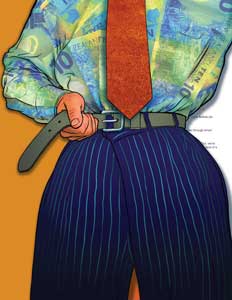CREDIT CONTROL IN DIFFICULT TIMES
A look at the current debt management/credit control scenario faced by business owners. How bad is it? What can you do about it? And what are the basic fundamentals of credit control to help you through the recession? By Kevin Kevany.
Almost all of us can cite the daily litany of how many billions of dollars got wasted on which financial institution today. We know how many thousands of jobs went to the wall in XYZ country yesterday. And what a mess (fill in the name of your least favourite politician) is making of trying to fix the awful state of the economy. Not that any of it matters a fig. It’s grim out there, and getting grimmer. No question. The fact that these events include some of New Zealand’s largest institutions is meant to offer some ‘Job’s comfort’ – that we are all in the same boat – but it doesn’t help one bit if you find yourself staring down the barrel of bankruptcy though, does it? As the marketers and CEOs don their armour and swallow handfuls of “be-happy-positive-and-downright-optimistic” pills, sallying forth into the everyday New Zealand business world, back home, those responsible for keeping the cashflow piping through are finding it increasingly difficult to do their vital daily tasks. According to Dun & Bradstreet NZ’s GM, John Scott, if you have debtors in the electric, gas and sanitary services sectors you have real problems already because they have been the slowest to pay for three consecutive quarters – a sure sign of trouble. If the mining sector is where you ply your trade, you’re all right, as they are the best payers. If you are an exporter, don’t expect to be paid in a hurry by your customers in India, Malaysia, Indonesia, Sri Lanka, Australia and Pakistan. And before you get on your high-horse, note that we are seventh on that list. Here’s a warning from Scott. “If you trade internationally, paying attention to your customers’ behaviours is particularly important. Being alert to early warning signs, such as a slowdown in payments, allows you to act quickly to protect your business from cashflow troubles and bad debts.” Ominously, in last quarter 2008, big companies (200-499 employees) overtook the smallest SMEs (1-5) to be the slowest payers at 52.6 days. There is a growing school of thought which believes our credit crisis began in August 2007 and resulted in a rapid decline in house sales (and house values); the sale of new and used vehicles; and the availability of employment opportunities – all of which were precursors to the global banking crisis which has yet to be fully felt by New Zealand, already under the whip for some 18 months. That might, of course, just not be as bad, but either way, local SME businesses face a massive challenge. Just how severe that will be (tourism, retail, specialist stores, building and services’ operations, generally, are predicted to be hard-pressed) will depend on the type of business you are in, your personality, luck and, most of all, your cashflow. If you add to the mix the fact the banks are – certainly in the eyes of some (admittedly with vested interests) – not exactly rushing to lend to SMEs (preferring mortgages); it’s not too soon to panic. “I think that’s ironic given banks’ exposure to large companies that weren’t run nearly as well,” says Ezypay CEO, Trent Brown. “I would describe the banks as architects of hard times. At first they allow easy access to finance and then remove finance quickly to SMEs across the board, irrespective of the fact that it might be a stable and growing business.” Jo Nel, GM NZ Operation of Baycorp (“the scrap metal dealers of the financial world”) has a solid international and local banking career behind him. He believes local banks are now being understandably more circumspect, both on the lending front and ditto on mortgagee sales and bankrupting anyone vaguely viable. “Banks will try to help where they possibly can. They strike me as being very flexible right now.” There must be some good news in that? What are the facts? Just how bad are things for SMEs in the first quarter of 2009? And you have to qualify any projections made from past data, simply because there does not appear to be a living soul who can accurately “call the bottom” and thereby predict the future and just how bad/not so bad it will really be. Veda Advantage, which holds files on around 97.5 percent of the individual, credit-active population and all of the commercial, credit-active population in New Zealand, provides credit reference checks for New Zealand’s major banks and keeps the score on how things went. It leaves the future to prophets and economists, but it is in a very strong position to spot trends. Managing director, John Roberts, notes: “The four months leading up to December had been tracking quite badly. In November in particular, we witnessed a 16 percent decrease in credit applications versus November 2007’s figures. We won’t know until January’s figures are available whether December was an aberration or not. “Possibly the impact of lower fuel costs, lower interest costs and reduced taxation are reinstalling some consumer confidence.” A bit of light at the end of the tunnel then? It might, of course, be the proverbial express train, if you take a global perspective from Dun and Bradstreet, probably the best known of the international “scorers”, when it comes to “payments performance”. Their data shows Kiwi consumers make New Zealand the seventh slowest-paying nation worldwide, measured by the percentage of overdue payments past 30 days – confirmation of the pressure our SMEs are already under. Our average number of debtor days has increased by 4.0 since September 2007. With ‘NZ Inc’ being measured as a “leading laggard” when it comes to putting the hand in the pocket, and “getting worse”, Ezypay’s Brown says small businesses will literally be starved of cashflow, if they have to wait any longer before being paid. “All businesses rely on solid cashflow to remain healthy and with average business-to-business payments more than 50 percent longer than the standard term it is not an acceptable business environment. “Whether it’s a cultural issue or a deliberate strategy by larger companies to use small businesses as an unofficial source of credit, SMEs have to protect themselves.” So how bad will it be? Indeed, according to EC Credit Control, which acts on behalf of three major New Zealand banks and 20,000 local SMEs, the time it takes a business to be paid had already reached an all-time high of 58 days and this is worsening every month. It is projected that by the time you read this, the period for settling accounts will exceed 65 days. “This will be exacerbated by the fact that debtors traditionally do not settle accounts over the December/January period. Business proprietors will have returned after the Christmas vacation to find their debtor’s ledger at an all-time high; the bank manager casting a wary eye over their overdrafts; and in many cases, banks may have decreased the facility previously available,” says founder and CEO John Harrison. “To add to business woes, tax payments will be due to the Government later this month (March).” He predicts that by next month (April), five to 10 percent of retailers will be out of business. He saw it coming, walking down Queen Street a month before Christmas with “70 percent off” sales de rigueur. That followed banks cutting back credit to 60-65 days – down from a 180 norm; before moving on creditors – “knowing at times like these, the first to claim is likely to be the only one to collect”. Is it surprising EC Credit Control loaded 70 percent more debt in December 2008 than 2007? They have also grown by just short of 60 percent in 2008 and expect the same rate in 2009. Their Napier administration centre staff numbers will have more than doubled in two years. CEO Harrison believes “things well get incredibly harsh” for at least two years. “In ’87, it was all about the stockmarket locally: this time it’s the entire global financial system.” Baycorp’s Nel says, like the banks, his organisation has been gearing up its technology with a $1.5 million upgrade, to increase the immediacy of accurate information on credit profiles. While not “totally pessimistic”, he believes the fact that the rural sector “won’t be there to pull us through this time” is a huge negative for the economy generally; although “we should never underestimate the Kiwi resilience”. In addition to debt collection and management, Baycorp handles legal processing and does the door-knocking to collect monies owed. Nel says it’s important for business owners to make sure that any collection agency they engage is a member of the NZCFI (New Zealand Credit and Finance Institute). What can you do? So how can business owners stay on top of debt management and credit control in these testing economic times? “Check and double-check references and credit histories; record your terms of trade correctly; don’t buy into promises; and remember, if things start to go wrong, the quicker you are to get us involved the more likely you are to be paid. Last-in-line is usually a waste of time,” Nel says. For starters, copy Leanne Powley’s Credit Control on Call’s essential guide (separate box) to staying on the side of the angels. If you find you still cannot reel in the payments in an acceptable timeframe, her organisation will do it for you – “with a more personal touch than the big guys” – at about $30 to $40 a month, irrespective of the amount involved. Powley’s South Auckland-based ledger control business has been running for just under two years, but “is going gang-busters” in the current environment, which she sees as being “very tough, probably for the next two years at least”. EC Credit Control recommends having your Terms of Trade documentation drawn up to include not only Application Forms but Work Authorisation Forms, Personal and Corporate Guarantees, Quotation and Variation Forms etc. It provides a “bullet-proof” document to protect not only your business, but also its shareholders. It also ensures that in the event of the debt having to be collected by a third party, all costs incurred, including commission, legal fees, court costs etc, are payable in full by the debtor. Ezypay’s Brown says their new finance paradigm moves debtors to lower payments on a more frequent basis. “This has the effect of reducing debtor days, which in turn lowers the cost of doing business. It involves SMEs being proactive in negotiating these new terms with their customers, and the concept of self-financing. “It rids healthy SMEs of an overdependence on a major bank and, ironically, they are also finding this solution far more cost-effective; exactly what they need in the current market conditions. This solution can be implemented so it is completely cost-neutral,” says Brown. Whatever you do, be informed, cautious and diligent. Kevin Kevany is an Auckland-based freelance writer, Email [email protected]




